One to one maths interventions built for KS4 success
Weekly online one to one GCSE maths revision lessons now available
In order to access this I need to be confident with:
This topic is relevant for:


Ratio Problem Solving
Here we will learn about ratio problem solving, including how to set up and solve problems. We will also look at real life ratio problems.
There are also ratio problem solving worksheets based on Edexcel, AQA and OCR exam questions, along with further guidance on where to go next if you’re still stuck.
What is ratio problem solving?
Ratio problem solving is a collection of word problems that link together aspects of ratio and proportion into more real life questions. This requires you to be able to take key information from a question and use your knowledge of ratios (and other areas of the curriculum) to solve the problem.
A ratio is a relationship between two or more quantities . They are usually written in the form a:b where a and b are two quantities. When problem solving with a ratio, the key facts that you need to know are,
- What is the ratio involved?
- What order are the quantities in the ratio?
- What is the total amount / what is the part of the total amount known?
- What are you trying to calculate ?
As with all problem solving, there is not one unique method to solve a problem. However, this does not mean that there aren’t similarities between different problems that we can use to help us find an answer.
The key to any problem solving is being able to draw from prior knowledge and use the correct piece of information to allow you to get to the next step and then the solution.
Let’s look at a couple of methods we can use when given certain pieces of information.
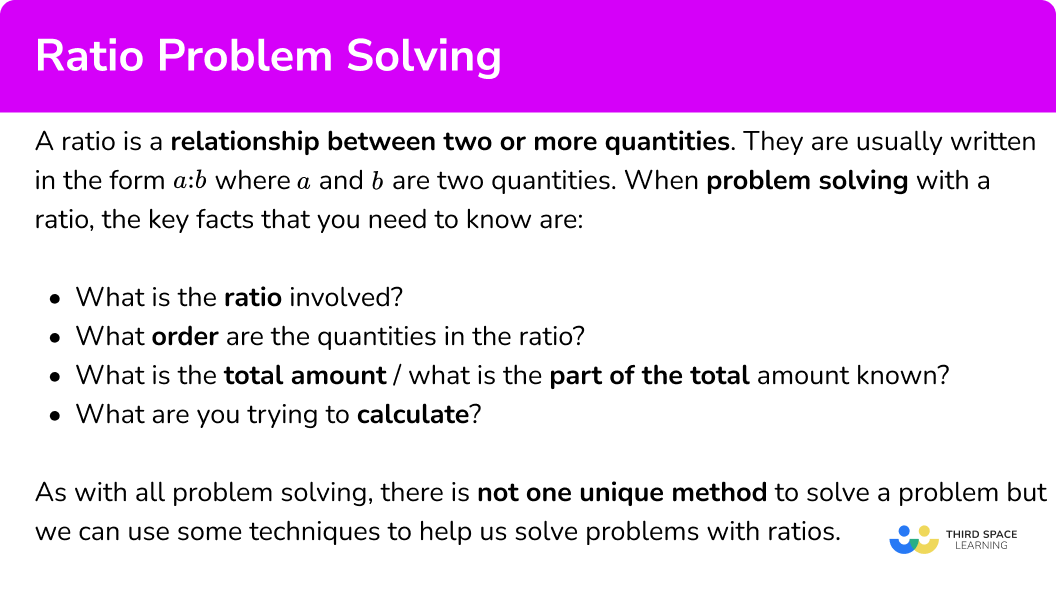
When solving ratio problems it is very important that you are able to use ratios. This includes being able to use ratio notation.
For example, Charlie and David share some sweets in the ratio of 3:5. This means that for every 3 sweets Charlie gets, David receives 5 sweets.
Charlie and David share 40 sweets, how many sweets do they each get?
We use the ratio to divide 40 sweets into 8 equal parts.
Then we multiply each part of the ratio by 5.
3 x 5:5 x 5 = 15:25
This means that Charlie will get 15 sweets and David will get 25 sweets.
- Dividing ratios
Step-by-step guide: Dividing ratios (coming soon)
Ratios and fractions (proportion problems)
We also need to consider problems involving fractions. These are usually proportion questions where we are stating the proportion of the total amount as a fraction.
Simplifying and equivalent ratios
- Simplifying ratios
Equivalent ratios
Units and conversions ratio questions
Units and conversions are usually equivalent ratio problems (see above).
- If £1:\$1.37 and we wanted to convert £10 into dollars, we would multiply both sides of the ratio by 10 to get £10 is equivalent to \$13.70.
- The scale on a map is 1:25,000. I measure 12cm on the map. How far is this in real life, in kilometres? After multiplying both parts of the ratio by 12 you must then convert 12 \times 25000=300000 \ cm to km by dividing the solution by 100 \ 000 to get 3km.
Notice that for all three of these examples, the units are important. For example if we write the mapping example as the ratio 4cm:1km, this means that 4cm on the map is 1km in real life.
Top tip: if you are converting units, always write the units in your ratio.
Usually with ratio problem solving questions, the problems are quite wordy . They can involve missing values , calculating ratios , graphs , equivalent fractions , negative numbers , decimals and percentages .
Highlight the important pieces of information from the question, know what you are trying to find or calculate , and use the steps above to help you start practising how to solve problems involving ratios.
How to do ratio problem solving
In order to solve problems including ratios:
Identify key information within the question.
Know what you are trying to calculate.
Use prior knowledge to structure a solution.
Explain how to do ratio problem solving
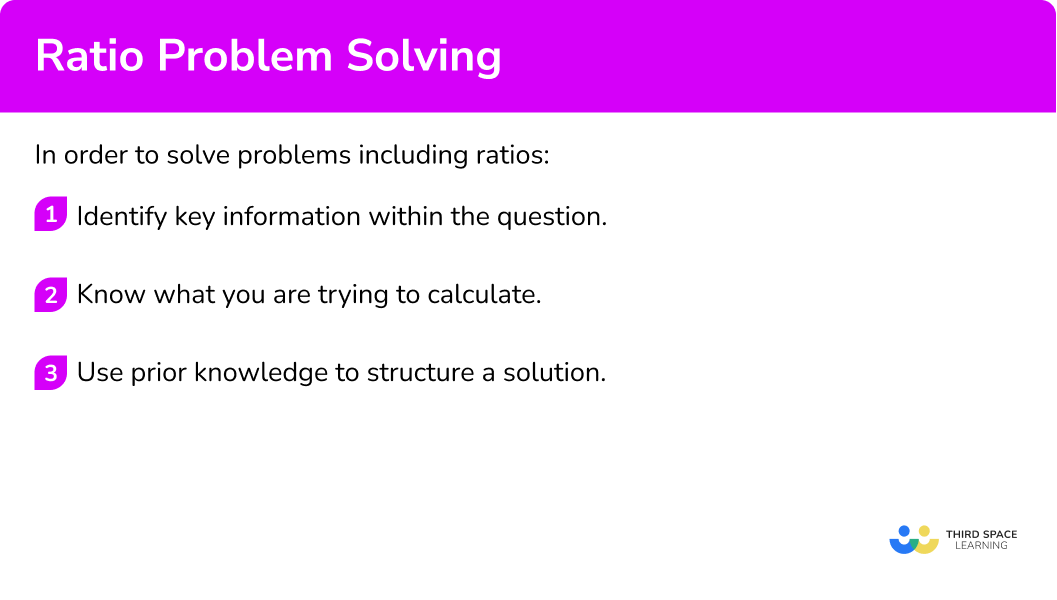
Ratio problem solving worksheet
Get your free ratio problem solving worksheet of 20+ questions and answers. Includes reasoning and applied questions.
Related lessons on ratio
Ratio problem solving is part of our series of lessons to support revision on ratio . You may find it helpful to start with the main ratio lesson for a summary of what to expect, or use the step by step guides below for further detail on individual topics. Other lessons in this series include:
- How to work out ratio
- Ratio to fraction
- Ratio scale
- Ratio to percentage
Ratio problem solving examples
Example 1: part:part ratio.
Within a school, the number of students who have school dinners to packed lunches is 5:7. If 465 students have a school dinner, how many students have a packed lunch?
Within a school, the number of students who have school dinners to packed lunches is \bf{5:7.} If \bf{465} students have a school dinner , how many students have a packed lunch ?
Here we can see that the ratio is 5:7 where the first part of the ratio represents school dinners (S) and the second part of the ratio represents packed lunches (P).
We could write this as

Where the letter above each part of the ratio links to the question.
We know that 465 students have school dinner.
2 Know what you are trying to calculate.
From the question, we need to calculate the number of students that have a packed lunch, so we can now write a ratio below the ratio 5:7 that shows that we have 465 students who have school dinners, and p students who have a packed lunch.

We need to find the value of p.
3 Use prior knowledge to structure a solution.
We are looking for an equivalent ratio to 5:7. So we need to calculate the multiplier. We do this by dividing the known values on the same side of the ratio by each other.
So the value of p is equal to 7 \times 93=651.
There are 651 students that have a packed lunch.
Example 2: unit conversions
The table below shows the currency conversions on one day.

Use the table above to convert £520 (GBP) to Euros € (EUR).

Use the table above to convert \bf{£520} (GBP) to Euros \bf{€} (EUR).
The two values in the table that are important are GBP and EUR. Writing this as a ratio, we can state

We know that we have £520.
We need to convert GBP to EUR and so we are looking for an equivalent ratio with GBP = £520 and EUR = E.

To get from 1 to 520, we multiply by 520 and so to calculate the number of Euros for £520, we need to multiply 1.17 by 520.
1.17 \times 520=608.4
So £520 = €608.40.
Example 3: writing a ratio 1:n
Liquid plant food is sold in concentrated bottles. The instructions on the bottle state that the 500ml of concentrated plant food must be diluted into 2l of water. Express the ratio of plant food to water respectively in the ratio 1:n.
Liquid plant food is sold in concentrated bottles. The instructions on the bottle state that the \bf{500ml} of concentrated plant food must be diluted into \bf{2l} of water . Express the ratio of plant food to water respectively as a ratio in the form 1:n.
Using the information in the question, we can now state the ratio of plant food to water as 500ml:2l. As we can convert litres into millilitres, we could convert 2l into millilitres by multiplying it by 1000.
2l = 2000ml
So we can also express the ratio as 500:2000 which will help us in later steps.
We want to simplify the ratio 500:2000 into the form 1:n.
We need to find an equivalent ratio where the first part of the ratio is equal to 1. We can only do this by dividing both parts of the ratio by 500 (as 500 \div 500=1 ).

So the ratio of plant food to water in the form 1:n is 1:4.
Example 4: forming and solving an equation
Three siblings, Josh, Kieran and Luke, receive pocket money per week proportional to their age. Kieran is 3 years older than Josh. Luke is twice Josh’s age. If Josh receives £8 pocket money, how much money do the three siblings receive in total?
Three siblings, Josh, Kieran and Luke, receive pocket money per week proportional to their ages. Kieran is \bf{3} years older than Josh . Luke is twice Josh’s age. If Luke receives \bf{£8} pocket money, how much money do the three siblings receive in total ?
We can represent the ages of the three siblings as a ratio. Taking Josh as x years old, Kieran would therefore be x+3 years old, and Luke would be 2x years old. As a ratio, we have

We also know that Luke receives £8.
We want to calculate the total amount of pocket money for the three siblings.
We need to find the value of x first. As Luke receives £8, we can state the equation 2x=8 and so x=4.
Now we know the value of x, we can substitute this value into the other parts of the ratio to obtain how much money the siblings each receive.
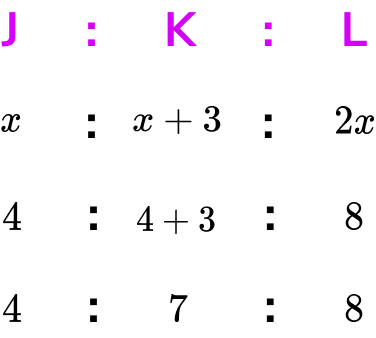
The total amount of pocket money is therefore 4+7+8=£19.
Example 5: simplifying ratios
Below is a bar chart showing the results for the colours of counters in a bag.
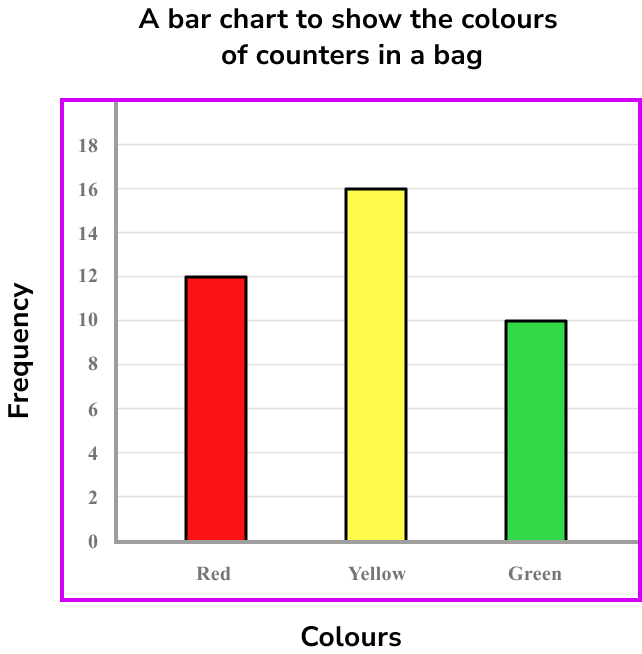
Express this data as a ratio in its simplest form.
From the bar chart, we can read the frequencies to create the ratio.

We need to simplify this ratio.
To simplify a ratio, we need to find the highest common factor of all the parts of the ratio. By listing the factors of each number, you can quickly see that the highest common factor is 2.
\begin{aligned} &12 = 1, {\color{red} 2}, 3, 4, 6, 12 \\\\ &16 = 1, {\color{red} 2}, 4, 8, 16 \\\\ &10 = 1, {\color{red} 2}, 5, 10 \end{aligned}
HCF (12,16,10) = 2
Dividing all the parts of the ratio by 2 , we get
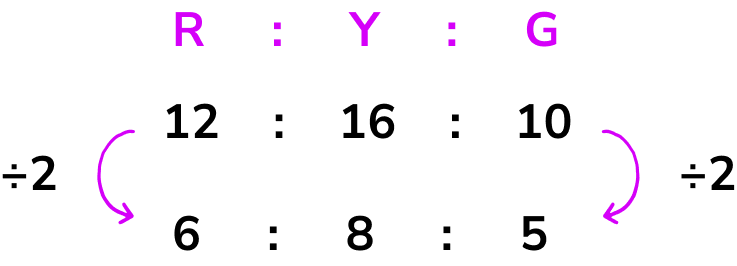
Our solution is 6:8:5 .
Example 6: combining two ratios
Glass is made from silica, lime and soda. The ratio of silica to lime is 15:2. The ratio of silica to soda is 5:1. State the ratio of silica:lime:soda.
Glass is made from silica, lime and soda. The ratio of silica to lime is \bf{15:2.} The ratio of silica to soda is \bf{5:1.} State the ratio of silica:lime:soda .
We know the two ratios

We are trying to find the ratio of all 3 components: silica, lime and soda.
Using equivalent ratios we can say that the ratio of silica:soda is equivalent to 15:3 by multiplying the ratio by 3.

We now have the same amount of silica in both ratios and so we can now combine them to get the ratio 15:2:3.
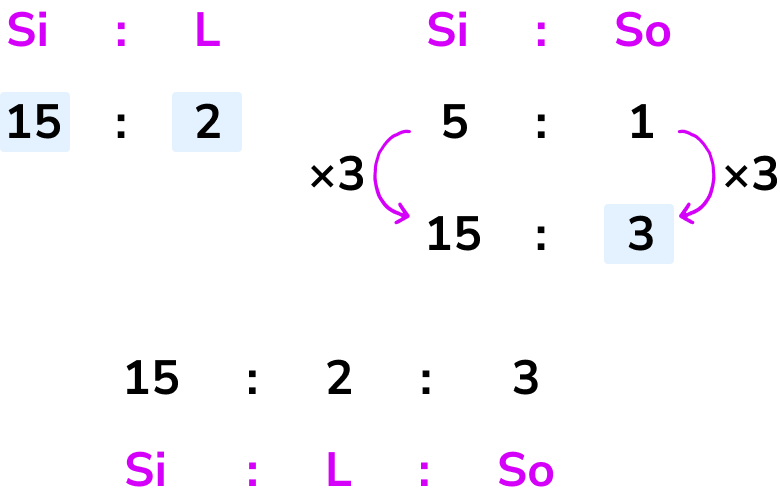
Example 7: using bar modelling
India and Beau share some popcorn in the ratio of 5:2. If India has 75g more popcorn than Beau, what was the original quantity?
India and Beau share some popcorn in the ratio of \bf{5:2.} If India has \bf{75g} more popcorn than Beau , what was the original quantity?
We know that the initial ratio is 5:2 and that India has three more parts than Beau.
We want to find the original quantity.
Drawing a bar model of this problem, we have

Where India has 5 equal shares, and Beau has 2 equal shares.
Each share is the same value and so if we can find out this value, we can then find the total quantity.
From the question, India’s share is 75g more than Beau’s share so we can write this on the bar model.

We can find the value of one share by working out 75 \div 3=25g.

We can fill in each share to be 25g.
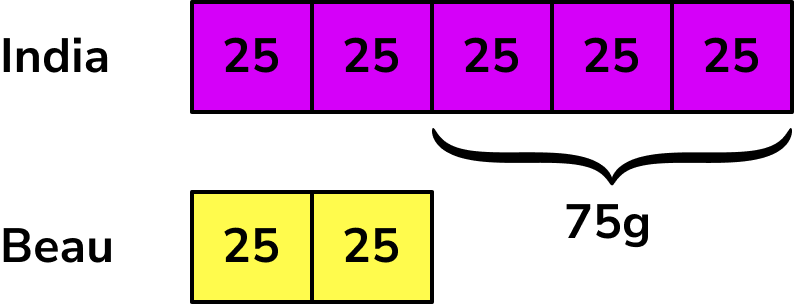
Adding up each share, we get
India = 5 \times 25=125g
Beau = 2 \times 25=50g
The total amount of popcorn was 125+50=175g.
Common misconceptions
- Mixing units
Make sure that all the units in the ratio are the same. For example, in example 6 , all the units in the ratio were in millilitres. We did not mix ml and l in the ratio.
- Ratio written in the wrong order
For example the number of dogs to cats is given as the ratio 12:13 but the solution is written as 13:12.
- Ratios and fractions confusion
Take care when writing ratios as fractions and vice-versa. Most ratios we come across are part:part. The ratio here of red:yellow is 1:2. So the fraction which is red is \frac{1}{3} (not \frac{1}{2} ).

- Counting the number of parts in the ratio, not the total number of shares
For example, the ratio 5:4 has 9 shares, and 2 parts. This is because the ratio contains 2 numbers but the sum of these parts (the number of shares) is 5+4=9. You need to find the value per share, so you need to use the 9 shares in your next line of working.
- Ratios of the form \bf{1:n}
The assumption can be incorrectly made that n must be greater than 1 , but n can be any number, including a decimal.
Practice ratio problem solving questions
1. An online shop sells board games and computer games. The ratio of board games to the total number of games sold in one month is 3:8. What is the ratio of board games to computer games?

8-3=5 computer games sold for every 3 board games.
2. The volume of gas is directly proportional to the temperature (in degrees Kelvin). A balloon contains 2.75l of gas and has a temperature of 18^{\circ}K. What is the volume of gas if the temperature increases to 45^{\circ}K?
3. The ratio of prime numbers to non-prime numbers from 1-200 is 45:155. Express this as a ratio in the form 1:n.
4. The angles in a triangle are written as the ratio x:2x:3x. Calculate the size of each angle.
5. A clothing company has a sale on tops, dresses and shoes. \frac{1}{3} of sales were for tops, \frac{1}{5} of sales were for dresses, and the rest were for shoes. Write a ratio of tops to dresses to shoes sold in its simplest form.
6. During one month, the weather was recorded into 3 categories: sunshine, cloud and rain. The ratio of sunshine to cloud was 2:3 and the ratio of cloud to rain was 9:11. State the ratio that compares sunshine:cloud:rain for the month.
Ratio problem solving GCSE questions
1. One mole of water weighs 18 grams and contains 6.02 \times 10^{23} water molecules.
Write this in the form 1gram:n where n represents the number of water molecules in standard form.
2. A plank of wood is sawn into three pieces in the ratio 3:2:5. The first piece is 36cm shorter than the third piece.
Calculate the length of the plank of wood.
5-3=2 \ parts = 36cm so 1 \ part = 18cm
3. (a) Jenny is x years old. Sally is 4 years older than Jenny. Kim is twice Jenny’s age. Write their ages in a ratio J:S:K.
(b) Sally is 16 years younger than Kim. Calculate the sum of their ages.
Learning checklist
You have now learned how to:
- Relate the language of ratios and the associated calculations to the arithmetic of fractions and to linear functions
- Develop their mathematical knowledge, in part through solving problems and evaluating the outcomes, including multi-step problems
- Make and use connections between different parts of mathematics to solve problems
The next lessons are
- Compound measures
- Best buy maths
Still stuck?
Prepare your KS4 students for maths GCSEs success with Third Space Learning. Weekly online one to one GCSE maths revision lessons delivered by expert maths tutors.

Find out more about our GCSE maths tuition programme.
Privacy Overview
Algebra: Ratio Word Problems
Related Pages Two-Term Ratio Word Problems More Ratio Word Problems Algebra Lessons
In these lessons, we will learn how to solve ratio word problems that have two-term ratios or three-term ratios.
Ratio problems are word problems that use ratios to relate the different items in the question.
The main things to be aware about for ratio problems are:
- Change the quantities to the same unit if necessary.
- Write the items in the ratio as a fraction .
- Make sure that you have the same items in the numerator and denominator.
Ratio Problems: Two-Term Ratios
Example 1: In a bag of red and green sweets, the ratio of red sweets to green sweets is 3:4. If the bag contains 120 green sweets, how many red sweets are there?
Solution: Step 1: Assign variables: Let x = number of red sweets.
Step 2: Solve the equation. Cross Multiply 3 × 120 = 4 × x 360 = 4 x
Answer: There are 90 red sweets.
Example 2: John has 30 marbles, 18 of which are red and 12 of which are blue. Jane has 20 marbles, all of them either red or blue. If the ratio of the red marbles to the blue marbles is the same for both John and Jane, then John has how many more blue marbles than Jane?
Solution: Step 1: Sentence: Jane has 20 marbles, all of them either red or blue. Assign variables: Let x = number of blue marbles for Jane 20 – x = number red marbles for Jane
Step 2: Solve the equation
Cross Multiply 3 × x = 2 × (20 – x ) 3 x = 40 – 2 x
John has 12 blue marbles. So, he has 12 – 8 = 4 more blue marbles than Jane.
Answer: John has 4 more blue marbles than Jane.
How To Solve Word Problems Using Proportions?
This is another word problem that involves ratio or proportion.
Example: A recipe uses 5 cups of flour for every 2 cups of sugar. If I want to make a recipe using 8 cups of flour. How much sugar should I use?
How To Solve Proportion Word Problems?
When solving proportion word problems remember to have like units in the numerator and denominator of each ratio in the proportion.
- Biologist tagged 900 rabbits in Bryer Lake National Park. At a later date, they found 6 tagged rabbits in a sample of 2000. Estimate the total number of rabbits in Bryer Lake National Park.
- Mel fills his gas tank up with 6 gallons of premium unleaded gas for a cost of $26.58. How much would it costs to fill an 18 gallon tank? 3 If 4 US dollars can be exchanged for 1.75 Euros, how many Euros can be obtained for 144 US dollars?
Ratio problems: Three-term Ratios
Example 1: A special cereal mixture contains rice, wheat and corn in the ratio of 2:3:5. If a bag of the mixture contains 3 pounds of rice, how much corn does it contain?
Solution: Step 1: Assign variables: Let x = amount of corn
Step 2: Solve the equation Cross Multiply 2 × x = 3 × 5 2 x = 15
Answer: The mixture contains 7.5 pounds of corn.
Example 2: Clothing store A sells T-shirts in only three colors: red, blue and green. The colors are in the ratio of 3 to 4 to 5. If the store has 20 blue T-shirts, how many T-shirts does it have altogether?
Solution: Step 1: Assign variables: Let x = number of red shirts and y = number of green shirts
Step 2: Solve the equation Cross Multiply 3 × 20 = x × 4 60 = 4 x x = 15
5 × 20 = y × 4 100 = 4 y y = 25
The total number of shirts would be 15 + 25 + 20 = 60
Answer: There are 60 shirts.
Algebra And Ratios With Three Terms
Let’s study how algebra can help us think about ratios with more than two terms.
Example: There are a total of 42 computers. Each computer runs one of three operating systems: OSX, Windows, Linux. The ratio of the computers running OSX, Windows, Linux is 2:5:7. Find the number of computers that are running each of the operating systems.

We welcome your feedback, comments and questions about this site or page. Please submit your feedback or enquiries via our Feedback page.

- school Campus Bookshelves
- menu_book Bookshelves
- perm_media Learning Objects
- login Login
- how_to_reg Request Instructor Account
- hub Instructor Commons
- Download Page (PDF)
- Download Full Book (PDF)
- Periodic Table
- Physics Constants
- Scientific Calculator
- Reference & Cite
- Tools expand_more
- Readability
selected template will load here
This action is not available.

5.5: Ratios and Proportions
- Last updated
- Save as PDF
- Page ID 129556

Learning Objectives
After completing this section, you should be able to:
- Construct ratios to express comparison of two quantities.
- Use and apply proportional relationships to solve problems.
- Determine and apply a constant of proportionality.
- Use proportions to solve scaling problems.
Ratios and proportions are used in a wide variety of situations to make comparisons. For example, using the information from Figure 5.15, we can see that the number of Facebook users compared to the number of Twitter users is 2,006 M to 328 M. Note that the "M" stands for million, so 2,006 million is actually 2,006,000,000 and 328 million is 328,000,000. Similarly, the number of Qzone users compared to the number of Pinterest users is in a ratio of 632 million to 175 million. These types of comparisons are ratios.
Constructing Ratios to Express Comparison of Two Quantities
Note there are three different ways to write a ratio , which is a comparison of two numbers that can be written as: /**/(\$ 1 =0.82\,{€})/**/, how many dollars should you receive? Round to the nearest cent if necessary.
Example 5.31
Solving a proportion involving weights on different planets.
A person who weighs 170 pounds on Earth would weigh 64 pounds on Mars. How much would a typical racehorse (1,000 pounds) weigh on Mars? Round your answer to the nearest tenth.
Step 1: Set up the two ratios into a proportion. Notice the Earth weights are both in the numerator and the Mars weights are both in the denominator.
170 64 = 1,000 x 170 64 = 1,000 x
Step 2: Cross multiply, and then divide to solve.
170 x = 1,000 ( 64 ) 170 x = 64,000 170 x 170 = 64,000 170 x = 376.5 170 x = 1,000 ( 64 ) 170 x = 64,000 170 x 170 = 64,000 170 x = 376.5
So the 1,000-pound horse would weigh about 376.5 pounds on Mars.
Your Turn 5.31
Example 5.32, solving a proportion involving baking.
A cookie recipe needs /**/1{\text{ inch}} =/**/ how many miles). Then use that scale to determine the approximate lengths of the other borders of the state of Wyoming.
Example 5.38
Solving a scaling problem involving model cars.
Die-cast NASCAR model cars are said to be built on a scale of 1:24 when compared to the actual car. If a model car is 9 inches long, how long is a real NASCAR automobile? Write your answer in feet.
The scale tells us that 1 inch of the model car is equal to 24 inches (2 feet) on the real automobile. So set up the two ratios into a proportion. Notice that the model lengths are both in the numerator and the NASCAR automobile lengths are both in the denominator.
1 24 = 9 x 24 ( 9 ) = x 216 = x 1 24 = 9 x 24 ( 9 ) = x 216 = x
This amount (216) is in inches. To convert to feet, divide by 12, because there are 12 inches in a foot (this conversion from inches to feet is really another proportion!). The final answer is:
216 12 = 18 216 12 = 18
The NASCAR automobile is 18 feet long.
Your Turn 5.38
Check your understanding, section 5.4 exercises.
- PRO Courses Guides New Tech Help Pro Expert Videos About wikiHow Pro Upgrade Sign In
- EDIT Edit this Article
- EXPLORE Tech Help Pro About Us Random Article Quizzes Request a New Article Community Dashboard This Or That Game Popular Categories Arts and Entertainment Artwork Books Movies Computers and Electronics Computers Phone Skills Technology Hacks Health Men's Health Mental Health Women's Health Relationships Dating Love Relationship Issues Hobbies and Crafts Crafts Drawing Games Education & Communication Communication Skills Personal Development Studying Personal Care and Style Fashion Hair Care Personal Hygiene Youth Personal Care School Stuff Dating All Categories Arts and Entertainment Finance and Business Home and Garden Relationship Quizzes Cars & Other Vehicles Food and Entertaining Personal Care and Style Sports and Fitness Computers and Electronics Health Pets and Animals Travel Education & Communication Hobbies and Crafts Philosophy and Religion Work World Family Life Holidays and Traditions Relationships Youth
- Browse Articles
- Learn Something New
- Quizzes Hot
- This Or That Game New
- Train Your Brain
- Explore More
- Support wikiHow
- About wikiHow
- Log in / Sign up
- Education and Communications
- Mathematics
How to Calculate Ratios
Last Updated: January 29, 2024 References
This article was co-authored by Grace Imson, MA . Grace Imson is a math teacher with over 40 years of teaching experience. Grace is currently a math instructor at the City College of San Francisco and was previously in the Math Department at Saint Louis University. She has taught math at the elementary, middle, high school, and college levels. She has an MA in Education, specializing in Administration and Supervision from Saint Louis University. This article has been viewed 3,109,041 times.
Ratios are mathematical expressions that compare two or more numbers. They can compare absolute quantities and amounts or can be used to compare portions of a larger whole. Ratios can be calculated and written in several different ways, but the principles guiding the use of ratios are universal to all.
Practice Problems

Understanding Ratios

- Ratios can be used to show the relation between any quantities, even if one is not directly tied to the other (as they would be in a recipe). For example, if there are five girls and ten boys in a class, the ratio of girls to boys is 5 to 10. Neither quantity is dependent on or tied to the other, and would change if anyone left or new students came in. The ratio merely compares the quantities.

- You will commonly see ratios represented using words (as above). Because they are used so commonly and in such a variety of ways, if you find yourself working outside of mathematic or scientific fields, this may the most common form of ratio you will see.
- Ratios are frequently expressed using a colon. When comparing two numbers in a ratio, you'll use one colon (as in 7 : 13). When you're comparing more than two numbers, you'll put a colon between each set of numbers in succession (as in 10 : 2 : 23). In our classroom example, we might compare the number of boys to the number of girls with the ratio 5 girls : 10 boys. We can simply express the ratio as 5 : 10.
- Ratios are also sometimes expressed using fractional notation. In the case of the classroom, the 5 girls and 10 boys would be shown simply as 5/10. That said, it shouldn't be read out loud the same as a fraction, and you need to keep in mind that the numbers do not represent a portion of a whole.
Using Ratios

- In the classroom example above, 5 girls to 10 boys (5 : 10), both sides of the ratio have a factor of 5. Divide both sides by 5 (the greatest common factor) to get 1 girl to 2 boys (or 1 : 2). However, we should keep the original quantities in mind, even when using this reduced ratio. There are not 3 total students in the class, but 15. The reduced ratio just compares the relationship between the number of boys and girls. There are 2 boys for every girl, not exactly 2 boys and 1 girl.
- Some ratios cannot be reduced. For example, 3 : 56 cannot be reduced because the two numbers share no common factors - 3 is a prime number, and 56 is not divisible by 3.

- For example, a baker needs to triple the size of a cake recipe. If the normal ratio of flour to sugar is 2 to 1 (2 : 1), then both numbers must be increased by a factor of three. The appropriate quantities for the recipe are now 6 cups of flour to 3 cups of sugar (6 : 3).
- The same process can be reversed. If the baker needed only one-half of the normal recipe, both quantities could be multiplied by 1/2 (or divided by two). The result would be 1 cup of flour to 1/2 (0.5) cup of sugar.

- For example, let's say we have a small group of students containing 2 boys and 5 girls. If we were to maintain this proportion of boys to girls, how many boys would be in a class that contained 20 girls? To solve, first, let's make two ratios, one with our unknown variables: 2 boys : 5 girls = x boys : 20 girls. If we convert these ratios to their fraction forms, we get 2/5 and x/20. If you cross multiply, you are left with 5x=40, and you can solve by dividing both figures by 5. The final solution is x=8.
Grace Imson, MA
Look at the order of terms to figure out the numerator and denominator in a word problem. The first term is usually the numerator, and the second is usually the denominator. For example, if a problem asks for the ratio of the length of an item to its width, the length will be the numerator, and width will be the denominator.
Catching Mistakes

- Wrong method: "8 - 4 = 4, so I added 4 potatoes to the recipe. That means I should take the 5 carrots and add 4 to that too... wait! That's not how ratios work. I'll try again."
- Right method: "8 ÷ 4 = 2, so I multiplied the number of potatoes by 2. That means I should multiply the 5 carrots by 2 as well. 5 x 2 = 10, so I want 10 carrots total in the new recipe."

- A dragon has 500 grams of gold and 10 kilograms of silver. What is the ratio of gold to silver in the dragon's hoard?

- The dragon has 500 grams of gold and 10,000 grams of silver.

- Example problem: If you have six boxes, and in every three boxes there are nine marbles, how many marbles do you have?

One common problem is knowing which number to use as a numerator. In a word problem, the first term stated is usually the numerator and the second term stated is usually the denominator. If you want the ratio of the length of an item to the width, length becomes your numerator and width becomes your denominator.
Community Q&A
You Might Also Like

- ↑ http://www.virtualnerd.com/common-core/grade-6/6_RP-ratios-proportional-relationships/A
- ↑ http://www.purplemath.com/modules/ratio.htm
- ↑ http://www.helpwithfractions.com/math-homework-helper/least-common-denominator/
- ↑ http://www.mathplanet.com/education/algebra-1/how-to-solve-linear-equations/ratios-and-proportions-and-how-to-solve-them
- ↑ http://www.math.com/school/subject1/lessons/S1U2L2DP.html
About This Article

To calculate a ratio, start by determining which 2 quantities are being compared to each other. For example, if you wanted to know the ratio of girls to boys in a class where there are 5 girls and 10 boys, 5 and 10 would be the quantities you're comparing. Then, put a colon or the word "to" between the numbers to express them as a ratio. In this example, you'd write "5 to 10" or "5:10." Finally, simplify the ratio if possible by dividing both numbers by the greatest common factor. To learn how to solve equations and word problems with ratios, scroll down! Did this summary help you? Yes No
- Send fan mail to authors
Reader Success Stories
Stew Jackson
Feb 9, 2021
Did this article help you?
Maria Bustos
May 3, 2021
Lynn Robinson
Apr 17, 2017
Mar 15, 2019
Dec 11, 2021

Featured Articles

Trending Articles

Watch Articles

- Terms of Use
- Privacy Policy
- Do Not Sell or Share My Info
- Not Selling Info
wikiHow Tech Help Pro:
Level up your tech skills and stay ahead of the curve

Maths with Mum
Be your child's best tutor
Solving Ratio Problems

- We add the parts of the ratio to find the total number of parts.
- There are 2 + 3 = 5 parts in the ratio in total.
- To find the value of one part we divide the total amount by the total number of parts.
- 50 ÷ 5 = 10.
- We multiply the ratio by the value of each part.
- 2:3 multiplied by 10 gives us 20:30.
- The 50 counters are shared into 20 counters to 30 counters.

- 2 + 3 = 5 and so there are 5 parts in the ratio in total.
- We divide by this total number of parts to find the value of each part.
- We multiply the original ratio by the value of each part.
- We have 20:30.

- Sharing in a Ratio: Part 1

Ratio Problems: Worksheets and Answers

How to Solve Ratio Problems

Share this:
- Click to share on Twitter (Opens in new window)
- Click to share on Facebook (Opens in new window)
- Click to share on WhatsApp (Opens in new window)
- Click to share on Pinterest (Opens in new window)
- Click to email a link to a friend (Opens in new window)
- Click to print (Opens in new window)
- Click to share on Tumblr (Opens in new window)
- Click to share on Pocket (Opens in new window)
- Click to share on Telegram (Opens in new window)
- Click to share on Skype (Opens in new window)
A ratio compares values .
A ratio says how much of one thing there is compared to another thing.
Ratios can be shown in different ways:
A ratio can be scaled up:
Try it Yourself
Using ratios.
The trick with ratios is to always multiply or divide the numbers by the same value .
Example: A Recipe for pancakes uses 3 cups of flour and 2 cups of milk.
So the ratio of flour to milk is 3 : 2
To make pancakes for a LOT of people we might need 4 times the quantity, so we multiply the numbers by 4:
3 ×4 : 2 ×4 = 12 : 8
In other words, 12 cups of flour and 8 cups of milk .
The ratio is still the same, so the pancakes should be just as yummy.
"Part-to-Part" and "Part-to-Whole" Ratios
The examples so far have been "part-to-part" (comparing one part to another part).
But a ratio can also show a part compared to the whole lot .
Example: There are 5 pups, 2 are boys, and 3 are girls
Part-to-Part:
The ratio of boys to girls is 2:3 or 2 / 3
The ratio of girls to boys is 3:2 or 3 / 2
Part-to-Whole:
The ratio of boys to all pups is 2:5 or 2 / 5
The ratio of girls to all pups is 3:5 or 3 / 5
Try It Yourself
We can use ratios to scale drawings up or down (by multiplying or dividing).
Example: To draw a horse at 1/10th normal size, multiply all sizes by 1/10th
This horse in real life is 1500 mm high and 2000 mm long, so the ratio of its height to length is
1500 : 2000
What is that ratio when we draw it at 1/10th normal size?
We can make any reduction/enlargement we want that way.
"I must have big feet, my foot is nearly as long as my Mom's!"
But then she thought to measure heights, and found she is 133cm tall, and her Mom is 152cm tall.
In a table this is:
The "foot-to-height" ratio in fraction style is:
We can simplify those fractions like this:
And we get this (please check that the calcs are correct):
"Oh!" she said, "the Ratios are the same".
"So my foot is only as big as it should be for my height, and is not really too big."
You can practice your ratio skills by Making Some Chocolate Crispies
- Math Article
- Ratios And Proportion
Ratios and Proportion
Ratio and Proportion are explained majorly based on fractions. When a fraction is represented in the form of a:b, then it is a ratio whereas a proportion states that two ratios are equal. Here, a and b are any two integers. The ratio and proportion are the two important concepts, and it is the foundation to understand the various concepts in mathematics as well as in science.

In our daily life, we use the concept of ratio and proportion such as in business while dealing with money or while cooking any dish, etc. Sometimes, students get confused with the concept of ratio and proportion. In this article, the students get a clear vision of these two concepts with more solved examples and problems.
For example, ⅘ is a ratio and the proportion statement is 20/25 = ⅘. If we solve this proportional statement, we get:
20 x 5 = 25 x 4
Check: Ratio and Proportion PDF
Therefore, the ratio defines the relationship between two quantities such as a:b, where b is not equal to 0. Example: The ratio of 2 to 4 is represented as 2:4 = 1:2. And the statement is said to be in proportion here. The application of proportion can be seen in direct proportion .
What is Ratio and Proportion in Maths?
The definition of ratio and proportion is described here in this section. Both concepts are an important part of Mathematics. In real life also, you may find a lot of examples such as the rate of speed (distance/time) or price (rupees/meter) of a material, etc, where the concept of the ratio is highlighted.
Proportion is an equation that defines that the two given ratios are equivalent to each other. For example, the time taken by train to cover 100km per hour is equal to the time taken by it to cover the distance of 500km for 5 hours. Such as 100km/hr = 500km/5hrs.
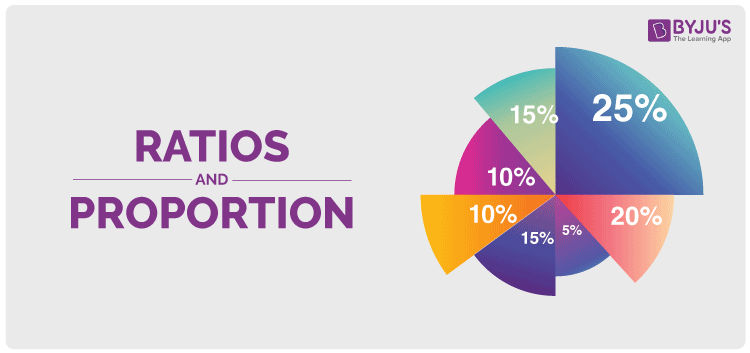
Let us now learn Maths ratio and proportion concept one by one.

Ratio Meaning
In certain situations, the comparison of two quantities by the method of division is very efficient. We can say that the comparison or simplified form of two quantities of the same kind is referred to as a ratio. This relation gives us how many times one quantity is equal to the other quantity. In simple words, the ratio is the number that can be used to express one quantity as a fraction of the other ones.
The two numbers in a ratio can only be compared when they have the same unit. We make use of ratios to compare two things. The sign used to denote a ratio is ‘:’.
A ratio can be written as a fraction, say 2/5. We happen to see various comparisons or say ratios in our daily life.
Hence, the ratio can be represented in three different forms, such as:
Key Points to Remember:
- The ratio should exist between the quantities of the same kind
- While comparing two things, the units should be similar
- There should be significant order of terms
- The comparison of two ratios can be performed, if the ratios are equivalent like the fractions
Definition of Proportion
Proportion is an equation that defines that the two given ratios are equivalent to each other. In other words, the proportion states the equality of the two fractions or the ratios. In proportion, if two sets of given numbers are increasing or decreasing in the same ratio, then the ratios are said to be directly proportional to each other.
For example, the time taken by train to cover 100km per hour is equal to the time taken by it to cover the distance of 500km for 5 hours. Such as 100km/hr = 500km/5hrs.
Ratio and proportions are said to be faces of the same coin. When two ratios are equal in value, then they are said to be in proportion . In simple words, it compares two ratios. Proportions are denoted by the symbol ‘::’ or ‘=’.
The proportion can be classified into the following categories, such as:
Direct Proportion
Inverse proportion, continued proportion.
Now, let us discuss all these methods in brief:
The direct proportion describes the relationship between two quantities, in which the increases in one quantity, there is an increase in the other quantity also. Similarly, if one quantity decreases, the other quantity also decreases. Hence, if “a” and “b” are two quantities, then the direction proportion is written as a∝b.
The inverse proportion describes the relationship between two quantities in which an increase in one quantity leads to a decrease in the other quantity. Similarly, if there is a decrease in one quantity, there is an increase in the other quantity. Therefore, the inverse proportion of two quantities, say “a” and “b” is represented by a∝(1/b).
Consider two ratios to be a: b and c: d .
Then in order to find the continued proportion for the two given ratio terms, we convert the means to a single term/number. This would, in general, be the LCM of means.
For the given ratio, the LCM of b & c will be bc.
Thus, multiplying the first ratio by c and the second ratio by b, we have
First ratio- ca:bc
Second ratio- bc: bd
Thus, the continued proportion can be written in the form of ca: bc: bd
Ratio and Proportion Formula
Now, let us learn the Maths ratio and proportion formulas here.
Ratio Formula
Assume that, we have two quantities (or two numbers or two entities) and we have to find the ratio of these two, then the formula for ratio is defined as;
where a and b could be any two quantities .
Here, “a” is called the first term or antecedent , and “b” is called the second term or consequent .
Example: In ratio 4:9, is represented by 4/9, where 4 is antecedent and 9 is consequent.
If we multiply and divide each term of ratio by the same number (non-zero), it doesn’t affect the ratio.
Example: 4:9 = 8:18 = 12:27
Also, read: Ratio Formula
Proportion Formula
Now, let us assume that, in proportion, the two ratios are a:b & c:d. The two terms ‘b’ and ‘c’ are called ‘means or mean term,’ whereas the terms ‘a’ and ‘d’ are known as ‘ extremes or extreme terms.’
Example: Let us consider one more example of a number of students in a classroom. Our first ratio of the number of girls to boys is 3:5 and that of the other is 4:8, then the proportion can be written as:
3 : 5 :: 4 : 8 or 3/5 = 4/8
Here, 3 & 8 are the extremes, while 5 & 4 are the means.
Note: The ratio value does not affect when the same non-zero number is multiplied or divided on each term.
Important Properties of Proportion
The following are the important properties of proportion:
- Addendo – If a : b = c : d, then a + c : b + d
- Subtrahendo – If a : b = c : d, then a – c : b – d
- Dividendo – If a : b = c : d, then a – b : b = c – d : d
- Componendo – If a : b = c : d, then a + b : b = c+d : d
- Alternendo – If a : b = c : d, then a : c = b: d
- Invertendo – If a : b = c : d, then b : a = d : c
- Componendo and dividendo – If a : b = c : d, then a + b : a – b = c + d : c – d
Difference Between Ratio and Proportion
To understand the concept of ratio and proportion, go through the difference between ratio and proportion given here.
Fourth, Third and Mean Proportional
If a : b = c : d, then:
- d is called the fourth proportional to a, b, c.
- c is called the third proportion to a and b.
- Mean proportional between a and b is √(ab).
Comparison of Ratios
If (a:b)>(c:d) = (a/b>c/d)
The compounded ratio of the ratios: (a : b), (c : d), (e : f) is (ace : bdf).
Duplicate Ratios
If a:b is a ratio, then:
- a 2 :b 2 is a duplicate ratio
- √a:√b is the sub-duplicate ratio
- a 3 :b 3 is a triplicate ratio
Ratio and Proportion Tricks
Let us learn here some rules and tricks to solve problems based on ratio and proportion topics.
- If u/v = x/y, then uy = vx
- If u/v = x/y, then u/x = v/y
- If u/v = x/y, then v/u = y/x
- If u/v = x/y, then (u+v)/v = (x+y)/y
- If u/v = x/y, then (u-v)/v = (x-y)/y
- If u/v = x/y, then (u+v)/ (u-v) = (x+y)/(x-y), which is known as componendo -Dividendo Rule
- If a/(b+c) = b/(c+a) = c/(a+b) and a+b+ c ≠0, then a =b = c
Ratio and Proportion Summary
- Ratio defines the relationship between the quantities of two or more objects. It is used to compare the quantities of the same kind.
- If two or more ratios are equal, then it is said to be in proportion.
- The proportion can be represented in two different ways. Either it can be represented using an equal sign or by using a colon symbol. (i.e) a:b = c:d or a:b :: c:d
- If we multiply or divide each term of the ratio by the same number, it does not affect the ratio.
- For any three quantities, the quantities are said to be in continued proportion, if the ratio between the first and second quantity is equal to the ratio between the second and third quantity.
- For any four quantities, they are said to be in continued proportion, if the ratio between the first and second quantities is equal to the ratio between the third and fourth quantities
Ratio And Proportion Examples
Example 1:
Are the ratios 4:5 and 8:10 said to be in Proportion?
4:5= 4/5 = 0.8 and 8: 10= 8/10= 0.8
Since both the ratios are equal, they are said to be in proportion.
Are the two ratios 8:10 and 7:10 in proportion?
8:10= 8/10= 0.8 and 7:10= 7/10= 0.7
Since both the ratios are not equal, they are not in proportion.
Example 3:
Given ratio are-
Find a: b: c.
Multiplying the first ratio by 5, second by 3 and third by 6, we have
a:b = 10: 15
b:c = 15 : 6
c:d = 6 : 24
In the ratio’s above, all the mean terms are equal, thus
a:b:c:d = 10:15:6:24
Check whether the following statements are true or false.
a] 12 : 18 = 28 : 56
b] 25 people : 130 people = 15kg : 78kg
The given statement is false.
12 : 18 = 12 / 18 = 2 / 3 = 2 : 3
28 : 56 = 28 / 56 = 1 / 2 = 1 : 2
They are unequal.
b] 25 persons : 130 persons = 15kg : 78kg
The given statement is true.
25 people : 130 people = 5: 26
15kg : 78kg = 5: 26
They are equal.
The earnings of Rohan is 12000 rupees every month and Anish is 191520 per year. If the monthly expenses of every person are around 9960 rupees. Find the ratio of the savings.
Savings of Rohan per month = Rs (12000-9960) = Rs. 2040
Yearly income of Anish = Rs. 191520
Hence, the monthly income of Anish = Rs. 191520/12 = Rs. 15960.
So, the savings of Anish per month = Rs (15960 – 9960) = Rs. 6000
Thus, the ratio of savings of Rohan and Anish is Rs. 2040: Rs.6000 = 17: 50.
Twenty tons of iron is Rs. 600000 (six lakhs). What is the cost of 560 kilograms of iron?
1 ton = 1000 kg 20 tons = 20000 kg The cost of 20000 kg iron = Rs. 600000 The cost of 1 kg iron = Rs{600000}/ {20000} = Rs. 30 The cost of 560 kg iron = Rs 30 × 560 = Rs 16800
The dimensions of the rectangular field are given. The length and breadth of the rectangular field are 50 meters and 15 meters. What is the ratio of the length and breadth of the field?
Length of the rectangular field = 50 m
Breadth of the rectangular field = 15 m
Hence, the ratio of length to breadth = 50: 15
⇒ 50: 15 = 10: 3.
Thus, the ratio of length and breadth of the rectangular field is 10:3.
Obtain a ratio of 90 centimetres to 1.5 meters.
The given two quantities are not in the same units.
Convert them into the same units.
1.5 m = 1.5 × 100 = 150 cm
Hence, the required ratio is 90 cm: 150 cm
⇒ 90: 150 = 3: 5
Therefore, the ratio of 90 centimetres to 1.5 meters is 3: 5.
There exists 45 people in an office. Out of which female employees are 25 and the remaining are male employees. Find the ratio of
a] The count of females to males.
b] The count of males to females.
Count of females = 25
Total count of employees = 45
Count of males = 45 – 25 = 20
The ratio of the count of females to the count of males
The count of males to the count of females
Example 10:
Write two equivalent ratios of 6: 4.
Given Ratio : 6: 4, which is equal to 6/4.
Multiplying or dividing the same numbers on both numerator and denominator, we will get the equivalent ratio.
⇒(6×2)/(4×2) = 12/8 = 12: 8
⇒(6÷2)/(4÷2) = 3/2 = 3: 2
Therefore, the two equivalent ratios of 6: 4 are 3: 2 and 12: 8
Example 11 :
Out of the total students in a class, if the number of boys is 5 and the number of girls is 3, then find the ratio between girls and boys.
The ratio between girls and boys can be written as 3:5 (Girls: Boys). The ratio can also be written in the form of factor like 3/5.
Example 12:
Two numbers are in the ratio 2 : 3. If the sum of numbers is 60, find the numbers.
Given, 2/3 is the ratio of any two numbers.
Let the two numbers be 2x and 3x.
As per the given question, the sum of these two numbers = 60
So, 2x + 3x = 60
Hence, the two numbers are;
2x = 2 x 12 = 24
3x = 3 x 12 = 36
24 and 36 are the required numbers.
Maths ratio and proportion are used to solve many real-world problems. Register with BYJU’S – The Learning App and get solutions for many difficult questions in easy methodology and followed by the step-by-step procedure.
Frequently Asked Questions on Ratios and Proportion
What is the ratio give an example., what is a proportion give example, how to solve proportions with examples, what is the concept of ratios, what are the two different types of proportions.
The two different types of proportions are: Direct Proportion Inverse Proportion
Can we express ratio in terms of fractions?
Yes, we can express ratio in terms of fractions. For example, 3: 4 can be expressed as 3/4.
What is the formula for ratio and proportion?
The formula for ratio is: x:y ⇒ x/y, where x is the first term and y is the second term. The formula for proportion is: p: q :: r : s ⇒ p/q = r/s, Where p and r are the first term in the first and second ratio q and s are the second term and in the first and second ratio.
Find the means and extremes of the proportion 1: 2 :: 3: 4.
In the given proportion 1: 2 :: 3: 4, Means are 2 and 3 Extremes are 1 and 4.

Put your understanding of this concept to test by answering a few MCQs. Click ‘Start Quiz’ to begin!
Select the correct answer and click on the “Finish” button Check your score and answers at the end of the quiz
Visit BYJU’S for all Maths related queries and study materials
Your result is as below
Request OTP on Voice Call
Leave a Comment Cancel reply
Your Mobile number and Email id will not be published. Required fields are marked *
Post My Comment
Very helpful
- Share Share
Register with BYJU'S & Download Free PDFs
Register with byju's & watch live videos.


- Parallelogram
- Quadrilateral
- Parallelepiped
- Tetrahedron
- Dodecahedron
- Fraction Calculator
- Mixed Fraction Calculator
- Greatest Common Factor Calulator
- Decimal to Fraction Calculator
- Whole Numbers
- Rational Numbers
- Place Value
- Irrational Numbers
- Natural Numbers
- Binary Operation
- Numerator and Denominator
- Order of Operations (PEMDAS)
- Scientific Notation
Last modified on August 3rd, 2023
Ratio Word Problems
Here, we will learn to do some practical word problems involving ratios.
Amelia and Mary share $40 in a ratio of 2:3. How much do they get separately?
There is a total reward of $40 given. Let Amelia get = 2x and Mary get = 3x Then, 2x + 3x = 40 Now, we solve for x => 5x = 40 => x = 8 Thus, Amelia gets = 2x = 2 × 8 = $16 Mary gets = 3x = 3 × 8 = $24
In a bag of blue and red marbles, the ratio of blue marbles to red marbles is 3:4. If the bag contains 120 green marbles, how many blue marbles are there?
Let the total number of blue marbles be x Thus, ${\dfrac{3}{4}=\dfrac{x}{120}}$ x = ${\dfrac{3\times 120}{4}}$ x = 90 So, there are 90 blue marbles in the bag.
Gregory weighs 75.7 kg. If he decreases his weight in the ratio of 5:4, find his reduced weight.
Let the decreased weight of Gregory be = x kg Thus, 5x = 75.7 x = \dfrac{75\cdot 7}{5} = 15.14 Thus his reduced weight is 4 × 15.14 = 60.56 kg
A recipe requires butter and sugar to be in the ratio of 2:3. If we require 8 cups of butter, find how many cups of sugar are required. Write the equivalent fraction.
Thus, for every 2 cups of butter, we use 3 cups of sugar Here we are using 8 cups of butter, or 4 times as much So you need to multiply the amount of sugar by 4 3 × 4 = 12 So, we need to use 12 cups of sugar Thus, the equivalent fraction is ${\dfrac{2}{3}=\dfrac{8}{12}}$
Jerry has 16 students in his class, of which 10 are girls. Write the ratio of girls to boys in his class. Reduce your answer to its simplest form.
Total number of students = 16 Number of girls = 10 Number of boys = 16 – 10 = 6 Thus the ratio of girls to boys is ${\dfrac{10}{6}=\dfrac{5}{3}}$
A bag containing chocolates is divided into a ratio of 5:7. If the larger part contains 84 chocolates, find the total number of chocolates in the bag.
Let the total number of chocolates be x
Then the two parts are:
${\dfrac{5x}{5+7}}$ and ${\dfrac{7x}{5+7}}$
${\dfrac{7x}{5+7}}$ = 84
=> ${\dfrac{7x}{12}}$ = 84
Thus, the total number of chocolates that were present in the bag was 144
Leave a Reply Cancel reply
Your email address will not be published. Required fields are marked *
Save my name, email, and website in this browser for the next time I comment.
About us Contact us
- Trigonometry
Join Our Newsletter
© 2024 Mathmonks.com . All rights reserved. Reproduction in whole or in part without permission is prohibited.

Step by Step tutorial on How to Solve Ratios In Mathematics
When we have to compare two or more than two numbers in mathematics then we can use ratios for the same as ratios can compare two or more quantitative numbers or amount or you can compare the portions of numbers of the larger numbers. Ratio is one of the tools of data analysts. This is why many people face difficulty in solving ratios so they are always in search of methods on how to solve ratios. If you are also stuck with solving ratios then this article will help you to understand the concept of ratios and methods on how to solve ratios.

Concept of ratio
Before learning the steps on how to solve ratios one must be well versed with ratios. As you can’t mug up mathematics you have to understand the concepts then only you can solve ratios.
First thing to learn is that ratios are used only in academics but also by data analysts for analysing the data in the form of comparison. Generally we think ratio compares only two numbers rather you can compare more than two numbers such as 3 or 4 through ratios.
Second thing to learn on how to solve ratios is that ratio basically states the relation of two or more numbers with each other.
Thirdly the sign of ratio is “:”. So if you want to tell someone that you got 75 marks in maths and your friend got 50 marks in maths then you can write it in the form of ratio as 75:50 that is 3:2.
Likewise you can write sex ratio of your class like 15 males and 10 females then you can write it as 15:10 that is 3:2. And we read the ratio as “isto”. So you will read it as 3 isto 2.
You can also write it in division form like 3/2.
Thus there are 3 ways to write ratios.
Steps – How to solve Ratios
The first step on how to solve the ratio is to write the values you want to compare and you can write such values in any given form like using colon or through division sign or by writing isto. Let’s understand the steps through an example. Suppose you want to take out the ratio of your maths and physics marks. You have got 90 marks in maths and 70 marks in physics. So firstly I will write it in the form of a ratio.
90 isto 70 or 90:70 or 90/70.
Second step on how to solve the problem is to reduce the values into their simplest way. So for that you can take out the common factors from the numbers. And then we can divide both of the numbers from such a common factor so that we can get the numbers in their simplest form. For example we have a number 90 : 70 then after writing it in the format of ratios now you have to bring out the common factors between the terms of ratios. So in this example we have 10 as a common factor. Thus you will divide both the numbers 90 and 70 by 10 so that you get the numbers in their simplest form so you will get 90/10:70/10 = 9:7.
Thus the ratio is 9:7.
Let’s take another example of three digits and three digits are 75 marks in biology, 25 marks in physics and 100 marks in maths. So let’s first write it in the form of ratio that is
75 : 25 : 100
Now we need to follow the next step of how to solve ratios. That is to find out the common factor from all the numbers thus we can clearly see that 25 is the common factor so you will have to divide each number with 25.
75/25 : 25/25 : 100/25
= 3 : 1 : 4
Thus the answer is 3:1:4.
The important point to learn in ratio is that it does not change with the multiplication or division of same numbers. It will remain the same. For example if you multiply the above number with 2 then they will become 75 x 2 : 25 x 2 : 100 x 2 = 150 : 50 : 200. Now also the ratio is same if you convert it to the smallest form then like first you have to divide it by 50 then you will find get the same ratio that is 3:1:2.
You can also find the value of variables if two ratios are equal. Let’s take an example to understand it better. Suppose you have one ratio 3:2 and other ratio 5:x and these two ratios are equal and now you are required to find the value of x song the equation will be
3 / 4 = 3/X
3 x X = 3 x 2
Ratios are the mathematical expressions used to compare two or more numbers having common factors. We also use ratios one daily basis. Although ratio is a simple mathematical concept still many people ask how to solve ratios . So we have written this article in the simplest language and steps wise with examples to solve ratios. Get the best help for math homework from the leading experts.
Similar Articles

Top 19 Tips & Tricks On How To Improve Grades?
Do you want to improve your grades? If yes, then don’t worry! In this blog, I have provided 19 tips…

How To Study For Final Exam – 12 Proven Tips You Must Know
How To Study For Final Exam? Studying for the final exam is very important for academic success because they test…
Leave a Comment Cancel Reply
Your email address will not be published. Required fields are marked *
This site uses Akismet to reduce spam. Learn how your comment data is processed .
- 1st Grade Math
- 2nd Grade Math
- 3rd Grade Math
- 4th Grade Math
- 5th Grade Math
- 6th Grade Math
- 7th Grade Math
- 8th Grade Math
- Knowledge Base
- Math for kids
Ratio Word Problems Worksheets
Created: March 29, 2024
Last updated: March 29, 2024
A ratio is a comparison between two things, showing how much one thing is related to another. It’s often written as a fraction, a colon, or the word “to.” Ratio word problems are practical situations where you must use these comparisons to solve a problem.
You can use ratio word problems worksheets to help kids understand the concept of ratios and how to use ratio word problems.
Benefits of ratio word problems worksheets with answers
Here are some of the benefits of ratio worksheets word problems:
- Ratio word problems 6th grade worksheets provide practical application for ratios for 6th graders who are trying to understand the concept of ratio.
- Ratio word problems worksheets PDF allows students to see how ratios are used in real-life situations.
- Ratio word problems worksheets 6th grade are designed to stimulate young learners’ interests and minds, unlike traditional teaching methods.
- Math ratio word problems worksheets help children develop analytical and critical thinking skills as they work through every problem on the sheets.
- Ratio word problem worksheets give kids something to practice with before exams and tests.
- The worksheets help kids familiarize themselves with ratios as a math concept.
Math for Kids
As a seasoned educator with a Bachelor’s in Secondary Education and over three years of experience, I specialize in making mathematics accessible to students of all backgrounds through Brighterly. My expertise extends beyond teaching; I blog about innovative educational strategies and have a keen interest in child psychology and curriculum development. My approach is shaped by a belief in practical, real-life application of math, making learning both impactful and enjoyable.
After-School Math Program

- Boost Math Skills After School!
- Join our Math Program, Ideal for Students in Grades 1-8!
Kid’s grade
After-School Math Program Boost Your Child's Math Abilities! Ideal for 1st-8th Graders, Perfectly Synced with School Curriculum!

Related worksheets
Multiplication is simple, but you need constant practice to perfect it. With multiplication worksheets for 5th grade, children can learn math unaided. An excellent 5th grade math multiplication worksheet will let you practice with your child at home. Proceed reading to learn which worksheets we recommend and where you can find them. Before we […]
Addition, which means bringing together, is one of the essential basic math operations every kid should learn. By kindergarten, kids Shildon already get used to number identification and can count correctly. As they transition to grade 1, the kids should know essential addition like 1 + 1 = 2. But how do you help the […]
Many children feel that math gets more overwhelming once teachers introduce them to a new topic, like rounding. There are many rounding strategies, and memorizing them all seems complicated to young minds. As a parent, you can help your children with fun and simple learning resources, like worksheets. At Brighterly, you can download colorful rounding […]
We use cookies to help give you the best service possible. If you continue to use the website we will understand that you consent to the Terms and Conditions. These cookies are safe and secure. We will not share your history logs with third parties. Learn More
Netflix's hit sci-fi series '3 Body Problem' is based on a real math problem that is so complex it's impossible to solve
- The three-body problem is a centuries-old physics question that puzzled Isaac Newton .
- It describes the orbits of three bodies, like planets or stars, trapped in each other's gravity.
- The problem is unsolvable and led to the development of chaos theory.

While Netflix's "3 Body Problem" is a science-fiction show, its name comes from a real math problem that's puzzled scientists since the late 1600s.
In physics, the three-body problem refers to the motion of three bodies trapped in each other's gravitational grip — like a three-star system.
It might sound simple enough, but once you dig into the mathematics, the orbital paths of each object get complicated very quickly.
Two-body vs. three- and multi-body systems
A simpler version is a two-body system like binary stars. Two-body systems have periodic orbits, meaning they are mathematically predictable because they follow the same trajectory over and over. So, if you have the stars' initial positions and velocities, you can calculate where they've been or will be in space far into the past and future.
However, "throwing in a third body that's close enough to interact leads to chaos," Shane Ross, an aerospace and ocean engineering professor at Virginia Tech, told Business Insider. In fact, it's nearly impossible to precisely predict the orbital paths of any system with three bodies or more.
While two orbiting planets might look like a ven diagram with ovular paths overlapping, the paths of three bodies interacting often resemble tangled spaghetti. Their trajectories usually aren't as stable as systems with only two bodies.
All that uncertainty makes what's known as the three-body problem largely unsolvable, Ross said. But there are certain exceptions.
The three-body problem is over 300 years old
The three-body problem dates back to Isaac Newton , who published his "Principia" in 1687.
In the book, the mathematician noted that the planets move in elliptical orbits around the sun. Yet the gravitational pull from Jupiter seemed to affect Saturn's orbital path.
Related stories
The three-body problem didn't just affect distant planets. Trying to understand the variations in the moon's movements caused Newton literal headaches, he complained.
But Newton never fully figured out the three-body problem. And it remained a mathematical mystery for nearly 200 years.
In 1889, a Swedish journal awarded mathematician Henri Poincaré a gold medal and 2,500 Swedish crowns, roughly half a year's salary for a professor at the time, for his essay about the three-body problem that outlined the basis for an entirely new mathematical theory called chaos theory .
According to chaos theory, when there is uncertainty about a system's initial conditions, like an object's mass or velocity, that uncertainty ripples out, making the future more and more unpredictable.
Think of it like taking a wrong turn on a trip. If you make a left instead of a right at the end of your journey, you're probably closer to your destination than if you made the mistake at the very beginning.
Can you solve the three-body problem?
Cracking the three-body problem would help scientists chart the movements of meteors and planets, including Earth, into the extremely far future. Even comparatively small movements of our planet could have large impacts on our climate, Ross said.
Though the three-body problem is considered mathematically unsolvable, there are solutions to specific scenarios. In fact, there are a few that mathematicians have found.
For example, three bodies could stably orbit in a figure eight or equally spaced around a ring. Both are possible depending on the initial positions and velocities of the bodies.
One way researchers look for solutions is with " restricted " three-body problems, where two main bodies (like the sun and Earth) interact and a third object with much smaller mass (like the moon) offers less gravitational interference. In this case, the three-body problem looks a lot like a two-body problem since the sun and Earth comprise the majority of mass in the system.
However, if you're looking at a three-star system, like the one in Netflix's show "3 Body Problem," that's a lot more complicated.
Computers can also run simulations far more efficiently than humans, though due to the inherent uncertainties, the results are typically approximate orbits instead of exact.
Finding solutions to three-body problems is also essential to space travel, Ross said. For his work, he inputs data about the Earth, moon, and spacecraft into a computer. "We can build up a whole library of possible trajectories," he said, "and that gives us an idea of the types of motion that are possible."
- Main content
Surprise! The federal government made a website that doesn’t stink.
I tried the irs free alternative to turbotax and here’s what you need to know..

Government websites have a mostly deserved reputation for being terrible and driving us nuts .
So it was a pleasant surprise to try IRS Direct File , a new (and politically controversial) option to file a tax return online directly with the Internal Revenue Service . Direct File works like TurboTax, but it’s run by the government and free to file a federal tax return.
Most people aren’t eligible to file their taxes with Direct File. I thought I could, was rejected partway through and instead used TurboTax.
Direct File was not perfect. Still, I liked using the IRS website — and I definitely prefer it over TurboTax, which annoys me with constant nags for more money and my private data.
You might feel differently about it. I’ll tell you about my experience with Direct File and why it’s important even if you don’t use the site.
We deserve effective online government services. Direct File is visible proof that government websites don’t have to stink.
How to file your taxes with IRS Direct File (if you can)
The first thing to know about Direct File is that it’s a trial project . And you probably can’t use it .
You can only file your tax return with the new IRS site if you’re in one of 12 states including Texas, New York and California; work for an employer rather than yourself; and meet many other eligibility requirements. (Read more here .)
Just going through Direct File’s seven online screens of eligibility checklists and doing an online identity verification almost made me quit.
Shira Ovide
But once I did start my tax return, Direct File felt pleasantly similar to TurboTax, which I have used for years.
Direct File guides you through yes or no questions about your income and potential tax breaks. You can chat online for help, too .
There are far fewer questions than there are in TurboTax because Direct File only permits use by people who have simple tax returns.
There were things I didn’t like. Unlike TurboTax, which had a digital copy of my W-2 tax form and let me pull in digital records from my investment accounts, I had to type into Direct File details like my income and interest payments.
That took more time and left room for me to mistype numbers.
The biggest problem was that part way through, Direct File told me that I couldn’t actually file my federal tax return with the site. Ugh.
I missed a detail in the eligibility checklist that you can’t use Direct File if you had more than $1,500 in interest income last year. I did. I was also nixed because I paid into a Health Savings Account, a fund through my employer to help pay for medical expenses.
I went through the whole Direct File process anyway to see how it went. And again, I was pleasantly surprised that the website was easy to use with clear questions and helpful explanations. And did I mention that it’s free? (If you can use it.)
A warning: Don’t mix up Direct File with existing IRS options to complete your tax return online.
You can also set up an account on the IRS Free File Fillable Forms website. Unlike Direct File or TurboTax, you need to go through the tax form yourself line by line. (Read more here about free or low-cost tax filing options.)
A colleague, Monica Rodman, found it confusing to use Free File Fillable Forms. Monica was so unsure of the results that they double checked the work with TurboTax. The whole process took 12 hours!
Monica gave up and had a good experience using Free Tax USA — which charged nothing to file a federal return and $15 for a state return.
The Free File Alliance, which runs Fillable Forms and a program called IRS Free File , has said about 463,000 households filed returns using Fillable Forms last year. NPR recently reported that more than 50,000 people have tried Direct File so far. Tens of millions of Americans file taxes with TurboTax each year.
The problem that IRS Direct File is trying to solve
Critics of Direct File in Congress and industry say the government is wasting money by replicating existing services like those from Intuit’s TurboTax, H&R Block and smaller tax preparers.
I can’t answer whether Direct File should exist or not. I can say as a technology writer and longtime user of TurboTax that commercial tax software drives me batty.
I like using TurboTax. But I hate that it nudges me over and over to pay more for extra features I don’t want. TurboTax also repeatedly tried to get me to use Credit Karma, a personal finance site also owned by Intuit.
And TurboTax wants permission to use private information like your income and debt to make more money pitching you financial services. ( Here’s how to say no to that .)
Direct File didn’t work for me, but I liked that it had zero yucky nagging as TurboTax has.
Intuit didn’t respond to my questions.
I know that not everyone will trust a government tax website. But I appreciate a choice between filing my tax return for free directly with the IRS or using a paid commercial website.
Hillary Hartley, chief executive of U.S. Digital Response , a nonprofit that helps governments create technology services, said citizens and government agencies benefit from competent public websites like Direct File.
We expect technology in our lives to just work. “When government can deliver on that same promise, then it pays dividends in rebuilding trust in our institutions,” Hartley said.
Julie Zauzmer Weil contributed to this report.
- Yes, you can file your tax return for free. Here are your options .
- The IRS says nearly 1 million people have an unclaimed tax refund from 2020. Here’s how to find out if the IRS owes you money .
- TurboTax and H&R Block now use AI for tax advice. It’s awful .

Follow Polygon online:
- Follow Polygon on Facebook
- Follow Polygon on Youtube
- Follow Polygon on Instagram
Site search
- What to Watch
- What to Play
- PlayStation
- All Entertainment
- Dragon’s Dogma 2
- FF7 Rebirth
- Zelda: Tears of the Kingdom
- Baldur’s Gate 3
- Buyer’s Guides
- Galaxy Brains
- All Podcasts
Filed under:
- Entertainment
The 3-body problem is real, and it’s really unsolvable
Oh god don’t make me explain math
Share this story
- Share this on Facebook
- Share this on Reddit
- Share All sharing options
Share All sharing options for: The 3-body problem is real, and it’s really unsolvable
/cdn.vox-cdn.com/uploads/chorus_image/image/73224177/3_Body_Problem_n_S1_E4_00_26_53_00RC.jpg_3_Body_Problem_n_S1_E4_00_26_53_00RC.0.jpg)
Everybody seems to be talking about 3 Body Problem , the new Netflix series based on Cixin Liu’s Remembrance of Earth’s Past book trilogy . Fewer people are talking about the two series’ namesake: The unsolvable physics problem of the same name.
This makes sense, because it’s confusing . In physics, the three-body problem attempts to find a way to predict the movements of three objects whose gravity interacts with each of the others — like three stars that are close together in space. Sounds simple enough, right? Yet I myself recently pulled up the Wikipedia article on the three-body problem and closed the tab in the same manner that a person might stagger away from a bright light. Apparently the Earth, sun, and moon are a three-body system? Are you telling me we don’t know how the moon moves ? Scientists have published multiple solutions for the three-body problem? Are you telling me Cixin Liu’s books are out of date?
All I’d wanted to know was why the problem was considered unsolvable, and now memories of my one semester of high school physics were swimming before my eyes like so many glowing doom numbers. However, despite my pains, I have readied several ways that we non-physicists can be confident that the three-body problem is, in fact, unsolvable.
Reason 1: This is a special definition of ‘unsolvable’
:no_upscale()/cdn.vox-cdn.com/uploads/chorus_asset/file/25343152/3BP_103_Unit_03306RC.jpg_3BP_103_Unit_03306RC.jpg)
The three-body problem is extra confusing, because scientists are seemingly constantly finding new solutions to the three-body problem! They just don’t mean a one-solution-for-all solution. Such a formula does exist for a two-body system, and apparently Isaac Newton figured it out in 1687 . But systems with more than two bodies are, according to physicists, too chaotic (i.e., not in the sense of a child’s messy bedroom, but in the sense of “chaos theory”) to be corralled by a single solution.
When physicists say they have a new solution to the three-body problem, they mean that they’ve found a specific solution for three-body systems that have certain theoretical parameters. Don’t ask me to explain those parameters, because they’re all things like “the three masses are collinear at each instant” or “a zero angular momentum solution with three equal masses moving around a figure-eight shape.” But basically: By narrowing the focus of the problem to certain arrangements of three-body systems, physicists have been able to derive formulas that predict the movements of some of them, like in our solar system. The mass of the Earth and the sun create a “ restricted three-body problem ,” where a less-big body (in this case, the moon) moves under the influence of two massive ones (the Earth and the sun).
What physicists mean when they say the three-body problem has no solution is simply that there isn’t a one-formula-fits-all solution to every way that the gravity of three objects might cause those objects to move — which is exactly what Three-Body Problem bases its whole premise on.
Reason 2: 3 Body Problem picked an unsolved three-body system on purpose
:no_upscale()/cdn.vox-cdn.com/uploads/chorus_asset/file/25325944/3_Body_Problem_n_S1_E3_00_34_33_04RC.jpg_3_Body_Problem_n_S1_E3_00_34_33_04RC.jpg)
Henri Poincaré’s research into a general solution to the three-body problem formed the basis of what would become known as chaos theory (you might know it from its co-starring role in Jurassic Park ). And 3 Body Problem itself isn’t about any old three-body system. It’s specifically about an extremely chaotic three-body system, the exact kind of arrangement of bodies that Poincaré was focused on when he showed that the problem is “unsolvable.”
[ Ed. note: The rest of this section includes some spoilers for 3 Body Problem .]
In both Liu’s books and Netflix’s 3 Body Problem , humanity faces an invasion by aliens (called Trisolarans in the English translation of the books, and San-Ti in the TV series) whose home solar system features three suns in a chaotic three-body relationship. It is a world where, unlike ours, the heavens are fundamentally unpredictable. Periods of icy cold give way to searing heat that give way to swings in gravity that turn into temporary reprieves that can never be trusted. The unpredictable nature of the San-Ti environment is the source of every detail of their physicality, their philosophy, and their desire to claim Earth for their own.
In other words, 3 Body Problem ’s three-body problem is unsolvable because Liu wanted to write a story with an unsolvable three-body system, so he chose one of the three-body systems for which we have not discovered a solution, and might never.
Reason 3: Scientists are still working on the three-body problem
Perhaps the best reason I can give you to believe that the three-body problem is real, and is really unsolvable, is that some scientists published a whole set of new solutions for specific three-body systems very recently .
If physicists are still working on the three-body problem, we can safely assume that it has not been solved. Scientists, after all, are the real experts. And I am definitely not.
The next level of puzzles.
Take a break from your day by playing a puzzle or two! We’ve got SpellTower, Typeshift, crosswords, and more.
Sign up for the newsletter Patch Notes
A weekly roundup of the best things from Polygon
Just one more thing!
Please check your email to find a confirmation email, and follow the steps to confirm your humanity.
Oops. Something went wrong. Please enter a valid email and try again.
Loading comments...
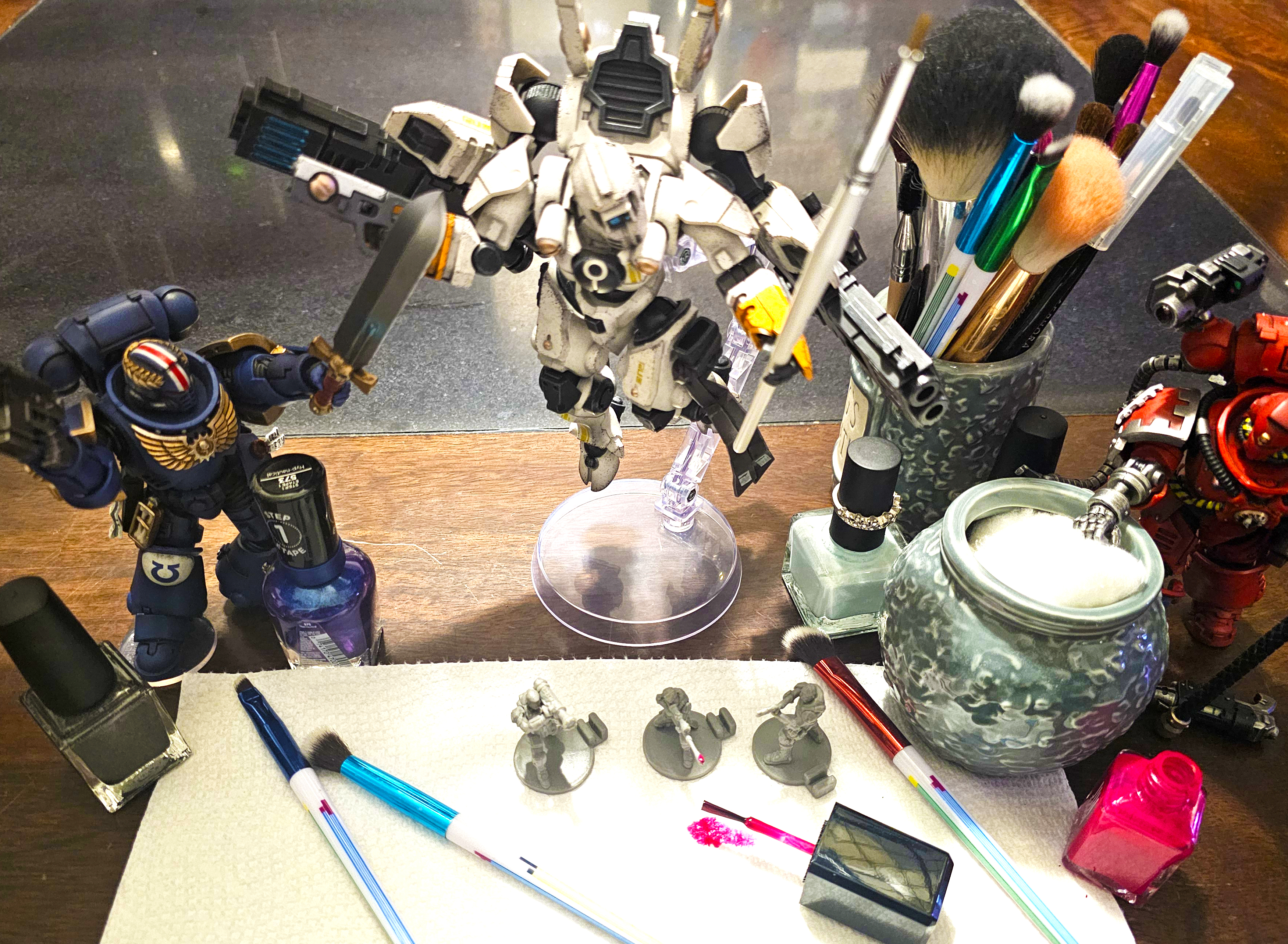
Glam up your Warhammer 40K minis with everyday products from the beauty aisle

Don’t have the time to read (or watch) Shōgun? Get the audiobooks for just $10

Cloud’s unreliable narration only makes Final Fantasy 7 Rebirth’s ending more confusing

Imaginary, Lisa Frankenstein, Netflix’s The Beautiful Game, and every new movie to watch at home this weekend

- Dragon’s Dogma 2 guides, walkthroughs, and explainers
Should you give the grimoires to Myrddin or Trysha in Dragon’s Dogma 2?

All maister skills in Dragon’s Dogma 2 and how to get them
- Share full article
Advertisement
Supported by
How Do You Solve a Problem Like ‘Bayadère’? Send In the Cowboys.
A new production of the ballet sets it in 1930s Hollywood instead of a mythic India, eliminating Orientalist clichés while embracing American ones.

By Marina Harss
One after the other, women in white step out of the wings, reaching forward into space before swaying gently back, arms overhead. Then they take two steps forward and begin the sequence all over again. This rocking motion, forward and back, repeats for several minutes, until the stage is filled with bodies hovering on pointe, as if sustained by a single breath.
The scene is from Marius Petipa’s “La Bayadère,” a ballet that premiered in St. Petersburg, Russia, in 1877. “The spectators must have felt that they had died and gone to heaven, which was more or less the case,” the dance critic Joan Acocella wrote in 2019 of the entrance of the Shades, or female spirits, in the second act.
That sequence — inspired by Gustave Doré’s illustration of souls descending from heaven in an edition of Dante’s “Divina Commedia” — is one of the reasons this ballet, set to a mostly unremarkable score by Ludwig Minkus, has survived when so many others have not.
“It’s a simple thing,” the director and choreographer Phil Chan said, “a throwaway step, even.” But the way the scene is structured, he added, “shows you how you can take a single step and give it to an entire group and make it look exciting and interesting.”
Like many operas and ballets from the 19th century, “La Bayadère,” set in an exoticized, ahistoric and sometimes cartoonish India, doesn’t translate well to our times. Some have questioned whether it should be performed at all . And while it continues to be staged around the world, there has been a noticeable reduction in performances, at least in the United States. In 2022, Susan Jaffe, the new artistic director of American Ballet Theater, said in an interview that it was one of the ballets she planned to shelve temporarily, while thinking about how to make changes.
What can be done with a work like “Bayadère”? For Chan and Doug Fullington, a specialist in 19th-century ballet, the solution is to remove it from its exotic context and put it in a setting closer to home, the Hollywood of the 1930s. By setting the ballet in a movie-land far west, and swapping Orientalist clichés for American ones, Chan said, the team was creating “a form of exoticism that is about us, not about ‘them.’”
“The thing is, there’s really nothing Indian about it,” he said of “Bayadère.” “We might as well add a German clog dance or an Argentine tango. It would literally be just as authentic.”
Called “Star on the Rise: La Bayadère … Reimagined!” the new version recasts the “Shades” scene as a dance spectacular à la Busby Berkeley. The staging, produced by Indiana University’s ballet department, will premiere on March 29 in Bloomington, and be livestreamed online as well as at the New York Public Library for the Performing Arts .
When “La Bayadère,” was made, far-off places were much in vogue in stage shows. Bizet’s 1863 opera “The Pearl Fishers” was set in Sri Lanka; Verdi’s 1871 opera “Aida” takes place in ancient Egypt; Spain was a frequent setting for both operas and ballets. In 1875, the Prince of Wales undertook a highly publicized tour of India and Sri Lanka (then Ceylon), both British colonies at the time. Two years later, “La Bayadère” came to the stage.
While in Sri Lanka, the prince had watched a dance performance, a moment that was illustrated in contemporary newspapers. Those illustrations are the likely inspiration for “La Bayadère’s” fast-paced “Danse Infernale,” a fake-tribal number set to a beating drum.
“It’s so problematic, but the music is so fun,” Chan said of “Danse Infernale.” “My idea was that we could take this thing that is so shameful, find the good parts, and make it fun for everybody.” The number, now called “Bronco Busters,” is danced by cowboys who slap their ankles, twirl lassoes and run with their arms behind their backs as if they were about to grab their pistols.
The story of “La Bayadère” hinges on a love triangle among Nikiya, a beautiful temple dancer, or bayadère; a not-so-brave warrior; and a rajah’s haughty daughter. Nikiya is a tragic heroine killed by a venomous snake placed in a basket of flowers by her catty rival.
Chan, born in Hong Kong, is a former dancer who now works to bring cultural awareness to ballet and opera. He has written two books on Orientalism in the performing arts and, with the former New York City Ballet dancer Georgina Pazcoguin, founded Final Bow for Yellowface , an organization that pushes for the elimination of demeaning depictions of Asian characters.
“I don’t think audiences want to see that anymore, this passive, hypersexualized, weak woman who has no agency,” he said about characters like Nikiya and the heroine of the opera “Madama Butterfly.” “Snooze-fest, boring. That’s not who we are anymore.”
Chan recently directed a production of “Madama Butterfly” at Boston Lyric Opera that transposed the story to World War II America; instead of a young geisha, the protagonist is a jazz singer. She doesn’t die at the end.
In “Star on the Rise,” Chan and Fullington’s heroine, a Hollywood starlet, also makes it out alive and takes charge of her destiny. Her rival has a change of heart. This paves the way to a happy ending, celebrated, in true movie musical style, with a big dance number, a Charleston.
Surprisingly, the translation from tragedy to comedy, and from exotic fantasyland to the world of musical theater, wasn’t such a stretch, they said. “I’ve always thought that a lot of the group choreography in ‘La Bayadère’ looked like dance-hall steps,” Fullington, who has co-written a book about Petipa’s ballets , said on a video call.
The plot, which verges on melodrama, easily lent itself to comic treatment. “If you flip these extreme situations in the ballet just a little bit, they become funny,” Fullington said.
The movie “Singin’ in the Rain” pointed to a way to adapt “La Bayadère” for its new Hollywood setting: a backstage story-within-a-story. In “Star on the Rise,” Nikiya becomes Nikki, an aspiring dancer and actress. Her rival, Pamela Zatti, is a longtime star, jealous of the spotlight. Sol is the matinee idol Nikki loves and Zatti wants as her leading man. The rivalry is professional, not romantic.
Chan and Fullington turned the ballet’s suite of colorful ensemble pieces into scenes from a Western fantasy being produced by the cast of the show. Instead of fakirs (ascetics) and dancing girls with parrots affixed to their wrists, the secondary characters have become cowboys, chorus dancers, buckaroos, sheriffs and falconers.
Drawing upon Fullington’s expertise in 19th-century steps and style, the pair decided to use choreography that hewed as closely to the original as possible, as laid out in ballet notations recorded in St. Petersburg when Petipa revived “La Bayadère” in 1900. Fullington is one of just few people in the world who know how to decipher them. (The choreographer Alexei Ratmansky and the Russian stager Sergei Vikharev have both done reconstructions based on these notations.)
The question was, how would these steps, created in Imperial Russia decades before the invention of jazz, let alone movie musicals, fit in with the new setting?
“Looking at the steps in isolation, without any narrative context, I thought they seemed very transferable,” Fullington said. “They weren’t exotic in any way.”
Simple moves like chugging hops on one leg and “paddle steps,” which have an up-down feel like an oompah in music, recur throughout the ballet. “The choreography is deceptively simple,” Chan said, “and it’s used in a way that builds and builds, and passes from one group to another group.”
Fullington and Chan have combined the notated steps with Western-inspired gestures like thumbs tucked in belt loops and tipped cowboy hats. In the studio, Fullington focused on staging the steps, and Chan on clarifying the storytelling and mime. In the passages that were not notated, and for the Charleston at the end, Fullington has created new steps or used steps drawn from other Petipa ballets.
But perhaps the most important element in bridging the two worlds is the ballet’s score, as reimagined by the veteran orchestrator Larry Moore, whose work includes editing a 1989 reconstruction of Gershwin’s “Girl Crazy.” Fullington sent him a piano reduction of the Minkus score and other materials, with the request that he should, as Moore said, “make the score sound more like 1930 than like 1877.”
Moore mostly kept Minkus’s melodies, while “lovingly tarting up the orchestral material,” he said, adding all manner of sounds and countermelodies. The new orchestration includes castanets, maracas, whips, a washboard, a guitar, a celesta and three saxophones. “I’ve got them playing everything but the kitchen sink, ” he said.
His sources of inspiration included the piano pieces of Scott Joplin, the song “Red River Valley” and the sophisticated Hollywood sound of Robert Russell Bennett, who orchestrated classic works like “Girl Crazy” and “Kiss Me Kate.”
To give the music a stronger dance impulse Moore played around with the rhythms, creating, at various points, a tango and a beguine, and adding percussion throughout. It was also his idea to turn the finale into a raucous Charleston. “I wanted a big happy ending, where they’re all happily dancing around,” he said.
Indiana University’s ballet program, part of the Jacobs School of Music, is one of the few that could take on such an ambitious project. The score will be performed by one of the school’s six orchestras. All of the school’s 68 dancers are involved in the show, as are faculty and 20 students from the affiliated Jacobs Academy. The scenic and costume designers (Mark Smith and Camille Deering) are also in-house.
For the student-dancers, it has been an eye-opening experience. Used to more neoclassical, abstract works, they’ve had to adapt to the filigreed classical steps and detailed storytelling and mime of “La Bayadère.” “You can’t just act with your eyes,” Maya Jackson, a sophomore performing the role of Nikki in one of the casts, said in a telephone interview, “you have to use your whole body.”
Stanley Cannon, who is playing a cowboy, is enjoying something he doesn’t often get to do in classical ballets: being part of a male ensemble. But he’s also excited about the larger picture the production represents. “The coolest thing hands down about this has been seeing the future of ballet,” he said.
Or, as Chan put it, “how do we keep these works that are such an important part of our dance heritage alive, but without the parts that no longer serve us?”
Stepping Into the World of Dance
The choreographer Emma Portner, who has spent her career mixing genres and disciplines , comes to ballet with an eye on its sometimes calcified gender relations.
In Irish dance, precision is prized. But perfection is beside the point at Gayli , a series of L.G.B.T.Q.-friendly ceili classes during March at Mary’s Bar, a queer Irish pub in Brooklyn.
A childhood encounter with an American soldier in Iraq led Hussein Smko to become a dancer. Now the artist performs on New York stages .
“Deep River” is in many ways an apt title for a dance work by Alonzo King, a choreographer fixated on flow .
Robert Garland has held many positions at Dance Theater of Harlem over many years. At long last, he has caught the most prized title: artistic director .
Alexei Ratmansky, arguably the most important ballet choreographer today, has stepped into a new role at New York City Ballet with a deeply personal first work that reflected his Ukrainian roots.

IMAGES
VIDEO
COMMENTS
Ratio problem solving is a collection of ratio and proportion word problems that link together aspects of ratio and proportion into more real life questions. This requires you to be able to take key information from a question and use your knowledge of ratios (and other areas of the curriculum) to solve the problem. ...
It compares the amount of one ingredient to the sum of all ingredients. part: whole = part: sum of all parts. To write a ratio: Determine whether the ratio is part to part or part to whole. Calculate the parts and the whole if needed. Plug values into the ratio. Simplify the ratio if needed.
Ratio problem solving is a collection of word problems that link together aspects of ratio and proportion into more real life questions. This requires you to be able to take key information from a question and use your knowledge of ratios (and other areas of the curriculum) to solve the problem.
Do you want to learn how to compare and measure different quantities using ratios and rates? Khan Academy's pre-algebra course offers you a comprehensive introduction to these concepts, with interactive exercises and videos. You will also learn how to use proportions to solve word problems and graph proportional relationships. Join Khan Academy and start your journey to master ratios and rates!
Ratio Word Problems: relating different things using ratios and algebra, how to solve ratio word problems that have two-term ratios or three-term ratios, How to solve proportion word problems, questions and answers, with video lessons, examples and step-by-step solutions.
In general, if you find a way to solve a problem that works for you, as long as you get the same numerical answer, you can use that method. We will cover proportions in the next section. In this section, we are choosing to focus on equivalent ratios as a method for problem-solving. Let's see one more example.
Ratios let us see how two values relate, especially when the values grow or shrink together. From baking recipes to sports, these concepts find their way into our lives on a daily basis. ... Solving ratio problems with tables (Opens a modal) Equivalent ratios (Opens a modal) Equivalent ratios: recipe (Opens a modal) Understanding equivalent ratios
Welcome to All About Ratios with Mr. J! Need help with ratios? You're in the right place!Whether you're just starting out, or need a quick refresher, this is...
Determine and apply a constant of proportionality. Use proportions to solve scaling problems. Ratios and proportions are used in a wide variety of situations to make comparisons. For example, using the information from Figure 5.15, we can see that the number of Facebook users compared to the number of Twitter users is 2,006 M to 328 M. Note ...
You can treat a ratio as a fraction or a division problem: 1:4 = 1 / 4 = 1 ÷ 4. Solve this problem with long division (or a calculator) and you'll get the answer as a decimal: 0.25. To make this a percent, just move the decimal point two spaces to the right: 0.25 = 25%. Thanks!
Solving Ratio Problems. We add the parts of the ratio to find the total number of parts. There are 2 + 3 = 5 parts in the ratio in total. To find the value of one part we divide the total amount by the total number of parts. 50 ÷ 5 = 10. We multiply the ratio by the value of each part. 2:3 multiplied by 10 gives us 20:30.
This video shows how to calculate Ratios of a number and then use that to solve multi-step ratio problems. With examples and practice for you to try on your ...
Art of Problem Solving's Richard Rusczyk introduces ratios.Learn more about problem solving at our website: http://bit.ly/ArtofProblemSolving
Using Ratios. The trick with ratios is to always multiply or divide the numbers by the same value. Example: A Recipe for pancakes uses 3 cups of flour and 2 cups of milk. So the ratio of flour to milk is 3 : 2. To make pancakes for a LOT of people we might need 4 times the quantity, so we multiply the numbers by 4: 3 ×4 : 2 ×4 = 12 : 8.
The compounded ratio of the ratios: (a : b), (c : d), (e : f) is (ace : bdf). Duplicate Ratios. If a:b is a ratio, then: a 2:b 2 is a duplicate ratio; √a:√b is the sub-duplicate ratio; a 3:b 3 is a triplicate ratio; Ratio and Proportion Tricks. Let us learn here some rules and tricks to solve problems based on ratio and proportion topics.
Definition: A comparison between quantities using division. Examples : 3:2 , 3:2:88, 3 to 2, 3 to 2 to 88. A 2 to 5 ratio can be represented as 2:5. A ration between X and Y can be written. X/Y. X:Y. X to Y. MEDIUM SAT PROBLEM#8 out of a 25 problem section. A bucket holds 4 quarts of popcorn.
You can cross-multiply to solve ratios. A more efficient way to solve equivalent ratios is by cross-multiplying. Consider the short-haired versus long-haired problem above. You can write the ratios as fractions instead. 2:3 can be written as 2/3. 12:x can be written as [ggfrac]12/x[/ggfrac].
Write the ratio of girls to boys in his class. Reduce your answer to its simplest form. Solution: Total number of students = 16. Number of girls = 10. Number of boys = 16 - 10 = 6. Thus the ratio of girls to boys is 10 6 = 5 3. A bag containing chocolates is divided into a ratio of 5:7. If the larger part contains 84 chocolates, find the ...
75/25 : 25/25 : 100/25. = 3 : 1 : 4. Thus the answer is 3:1:4. The important point to learn in ratio is that it does not change with the multiplication or division of same numbers. It will remain the same. For example if you multiply the above number with 2 then they will become 75 x 2 : 25 x 2 : 100 x 2 = 150 : 50 : 200.
It's often written as a fraction, a colon, or the word "to." Ratio word problems are practical situations where you must use these comparisons to solve a problem. You can use ratio word problems worksheets to help kids understand the concept of ratios and how to use ratio word problems. Benefits of ratio word problems worksheets with answers
Discover how to solve ratio problems with a real-life example involving indoor and outdoor playtimes. Learn to use ratios to determine the number of indoor and outdoor playtimes in a class with a 2:3 ratio and 30 total playtimes. ... What you need to do in any word problem involving the ratios is exactly the same. Take the entire amount and ...
Regulators, airlines, fliers and even Boeing's own workers are practically in revolt after a series of mid-flight disasters and a steady erosion of the company's quality standards. Investors ...
Produced by Alex Barron. Edited by Lynn Levy. Engineered by Efim Shapiro. Featuring Dennis Overbye. The show "3 Body Problem" premiered on March 21 and quickly became one of Netflix's most ...
In this video I'll show you how to solve multiple types of Ratio Word Problems using 5 examples. We'll start simple and work up to solving the most complex p...
Netflix. The three-body problem is a centuries-old physics question that puzzled Isaac Newton. It describes the orbits of three bodies, like planets or stars, trapped in each other's gravity. The ...
The problem that IRS Direct File is trying to solve Critics of Direct File in Congress and industry say the government is wasting money by replicating existing services like those from Intuit's ...
In other words, 3 Body Problem 's three-body problem is unsolvable because Liu wanted to write a story with an unsolvable three-body system, so he chose one of the three-body systems for which ...
March 23, 2024. One after the other, women in white step out of the wings, reaching forward into space before swaying gently back, arms overhead. Then they take two steps forward and begin the ...